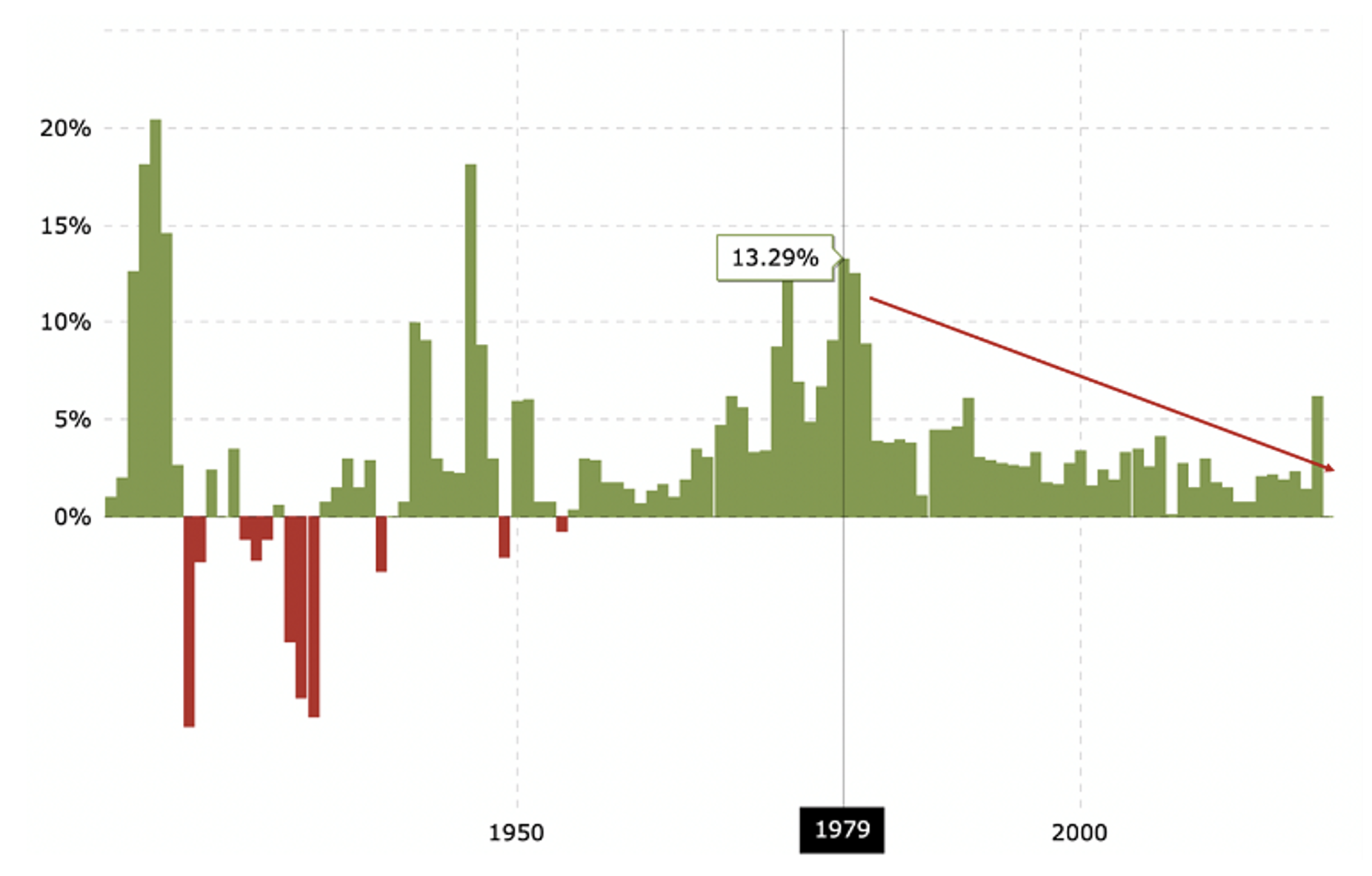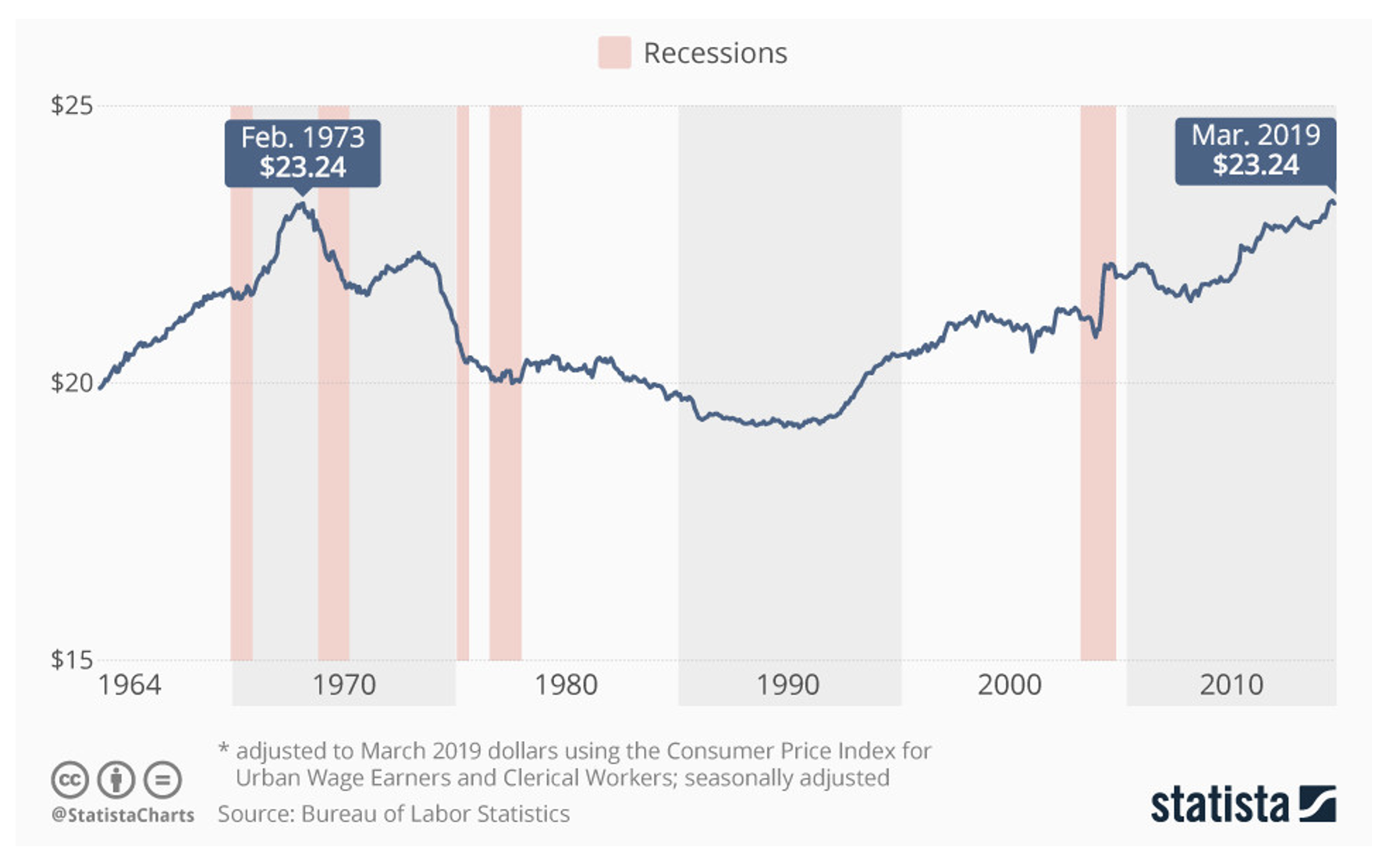
How AI will put a lid on incomes – and inflation
Despite all the money that’s been pumped into the economy, inflation may not be a problem in the longer term. After all, money supply has been rising at an exponential rate since the 1960s and yet, since 1980, inflation has been in decline. I believe there are two key structural reasons for this – the massive drop in unionized labour, and the rise of job-displacing automation.
First, unionised labour is a fraction of what it was just three decades ago. Large, collectively negotiated annual wage increases are a thing of the past. In the U.S., a similar lid on wages exists due to the level of unionised labour declining precipitously in recent decades. When wage growth is low, a large component of the pressure on consumer prices is removed.
Second, while we’ve all been discussing COVID-19 vaccinations and reopening, the world has been investing a record amount in technology, particularly automation. Automation displaces labour, hammering another nail in the coffin of [sustained] wage growth.”
Figure 1. Historical U.S. core inflation to 2021

With wage growth likely to be under sustained pressure, it’s hard to imagine how consumer prices can rise sustainably unless corporates gouge their customers, which they might do without regulation or sufficient competition. But sustained gouging shouldn’t be possible, even in the absence of regulation, if wages are under constant downward pressure.
For example, some might argue the story of Henry Ford, who is said to have given his staff a pay rise, famously paying them $5 per day, because “he realised that he should pay his workers sufficiently large sums so they could afford the products they were making. In this manner he could expand the market for his products.”
The reality is that in 1913, Ford had to hire 52,000 men to maintain a workforce of 14,000, such was the churn on his assembly line. When employees quit, manufacturing stopped, and to keep the product cheap, Ford required a high throughput.
But with automation today, there won’t be 14,000 staff required in the first place. Churn won’t exist because staff won’t exist, and therefore, neither will the requirement to raise salaries.
Figure 2. A long-term view of U.S. wages (real hourly earnings for production and nonsupervisory roles)

Back in 2019, the World Economic Forum, liberty calculated real wages in 2019 prices and took a look at what wages from 1964 onwards would be worth in 2019. 2019 U.S. wages were at a historically high level, with average hourly earnings in March 2019 amounting to $23.24 in 2019 dollars. But that only matches the peak of March 1974, when hourly wages adjusted to 2019 dollars amounted to exactly the same sum.
The downward pressure on wages in only being masked by the effects of the pandemic and that obfuscation is likely to be temporary.
Putting aside the Armageddon and citizen uprising scenarios some ‘sceptinet’ citizens proffer, the path to automation is well underway and likely to be accelerated by AI. It’s impact on wages will also begin to accelerate. And two announcements overnight, by giants in their respective industries, are portents of an automated and lower-inflation future.
The first is from U.S. mega retailer, Walmart.
In its carefully worded announcement, Walmart discusses its investment in AI being “centered around people” while “leveraging a state-of-the-art integrated supply chain network…to deliver…margin expansion and higher return on investment”.
Walmart adds, “As we grow, we will improve our operating margin through productivity advancements and our category and business mix and drive returns through operating margin expansion and capital prioritisation.”
Showcasing its supply chain innovation this week at its Brooksville, Florida, regional distribution centre, the company plans to re-engineer its supply chain with “a more intelligent” and connected omnichannel network that is enabled by greater use of data, more intelligent software and automation.
The key word there might just be ‘automation’. By the end of Fiscal Year 2026, Walmart believes approximately 55 per cent of the fulfilment centre volume will move through automated facilities, and roughly 65 per cent of stores will be serviced by automation, offering average improvements to average unit costs of 20 per cent.
With more than half of the distribution centre volumes running through automated facilities, one does not need to imagine what will happen to jobs. Fortunately, the company offers some arguably meaningless motherhood statements on the subject:
“It all starts with our associates”, and “We are a people-led, tech-powered omnichannel retailer. As it relates to being people-led, it’s about purpose, values, culture, opportunity and belonging.”
And this, “We help bring dignity to work by enabling them to see how they’re serving others, as part of a team, and helping them achieve their potential.”
Nice.
Perhaps tellingly, however, Walmart’s executive vice president and chief financial officer noted, “We believe that we have the building blocks in place to help define the next chapter of retail and do so while driving strong growth and shareholder returns.”
Meanwhile, design software mega-cap, Adobe, is moving technology that was once the exclusive domain of professionals, towards the masses, arguably undermining the former’s ability to command premium income, while also destabilising truth in news.
As Axios reports, “Concerns are running high that the technology to alter images in deceptive ways is advancing far faster than the ability of humans or machines to detect such fakes.
“For example, a fake image of the Pentagon — showing an explosion that never took place — was shared on Twitter, reportedly even causing a brief financial market dip before it was clearly shown to be fake.
“The fake image gained extra attention because it came from a “verified” account that had Bloomberg in the name, falsely suggesting the image came from Bloomberg News.”
“Adobe announced it is bringing generative AI into Photoshop with a new “generative fill” tool that can be used to add or remove objects, change backgrounds and more. Such changes can range from subtle to dramatic and have a wide range of uses, including expanding creativity and saving time for professional artists.”
But the software can also be used to extend an image beyond its boundaries, with generative AI helping fill in the wider canvas, using what’s already in the image to extrapolate new “uncropped” content. In doing so it further blurs the lines between what is real and unreal.
And why Adobe will pay creators for images created using their AI powered tools, one wonders how creators can possibly earn the same revenue when what once took hours, or even days, now takes seconds. One also wonders how the big issue of consent is being tackled when original IP and art is utilized in training AI and whether creators and artists are compensated.
As an aside, (AI) will be revolutionary. We believe the easy to spot winners will initially be the profitable mega-cap tech companies, not least because VC funding for disruptive start-ups has been severely throttled thanks to higher interest rates and falling private company valuations.